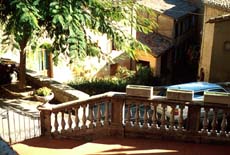index
The hill towns
The hill towns are very physical. This is not just visual, it is the way sounds echo, the smells, the color and texture of the stones in the walls, the twists and bumps underfoot, the changes in the level of the street with thoughtful little ramps and curving steps, the constrictions and flow and distension of space in the streets and piazzas. The constant variation underfoot locates you. Everywhere there are edges and shadows. There is no overall geometric plan, but there is care for the changing views. Spatially, the towns vary. There is a common general grammar polarized between the city gates and the main piazza that holds church and government buildings. The layout in-between these poles does not follow a single pattern. The combination of distinct poles and irregular middle zones lets these small towns accept the tourist flows without being so disrupted as more hierarchical spaces might be. Though the materials and building types remain similar, spatial effects vary. Siena with its long narrow high-walled streets and few piazzas shapes a different space and movement than Orvieto with its shorter street segments and many small openings in the fabric of the city. Montepulciano, the highest of the larger hill towns, makes the hill itself very present in its steep streets and its glimpses down onto valley fields through little arched alleyways, then through sudden streetside vistas onto wide panoramas. Orvieto cannot be seen from within itself, but in Montepulciano some points on the inside of the curve of the city offer views of the outside of other parts of the city. At Montalcino a grid drapes over the hill top, ignoring the contours of the land, with height changes everywhere along the streets. San Quirico d'Orcia blends into its contemporary surrounding smoothly rather than being elevated above it. Gubbio climbs up its hillside, with the mountain above and the valley beyond changing as you ascend. Castello di Murlo sits in tiny splendid isolation, twenty houses and one or two public buildings around three little piazzas with no streets at all. Urbino claims several hills, offering views of itself from inside, self-referential in its independence. Montefollonico, empty at siesta after the rain, falls away from its medieval core in narrow streets that abruptly cast you downhill. Radda in Chianti offers an inward piazza opening to a park and a wide curve of street overlooking the valley. Castellana mounts to a summit piazza and tower. Pienza along its narrow ridge has its historic street paralleled by a newer road. One main street, parallel streets, a grid, a labyrinth, flow and piazzas, high and low, narrow and wide, the highway bypassing or going through, views within or out, uniform heights or abrupt changes: these make for different spatial effects within the overall type. The stone walls are punctuated by intense little gardens, not French or English, with everyday items, a little disorderly. There is street texture on many scales. The general rhythm of streets and piazzas makes the town a mosaic like the street paving, irregular stones and facades and buildings set together to make a whole that is more than any one of them, viewable at different distances. The grammars of action make an irregular pattern too, overlapping and reinforcing each other. At night the towns close upon themselves, shuttered and empty, with spots of light and noise as occasional hints of liveliness inside the stone walls. Recall Asciano at sunset, as we met at the fountain among teenagers at their rituals.



